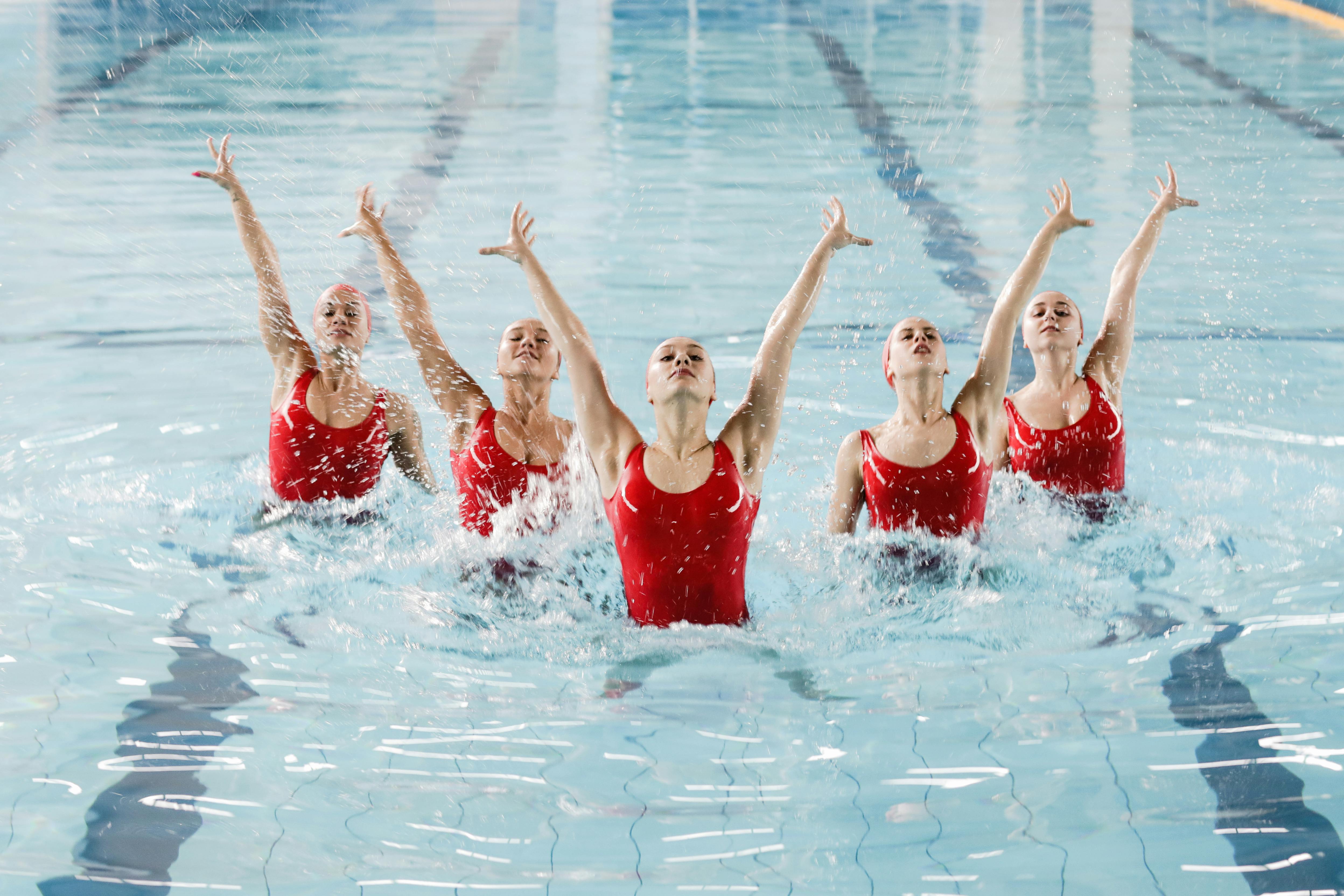Synchronized Swimming: The Aquatic Ballet Revolution
Synchronized swimming, a mesmerizing blend of dance, gymnastics, and aquatics, has captivated audiences for decades. This unique sport combines grace, strength, and precision, pushing the boundaries of human performance in water. As we explore the intricacies of synchronized swimming, we'll uncover its rich history, technical demands, and the incredible athleticism required to excel in this challenging discipline. From its humble beginnings to its current status as an Olympic sport, synchronized swimming has evolved into a spectacular showcase of human potential and artistic expression in the aquatic realm.

The sport’s competitive structure began to take shape in the 1950s, with the first U.S. National Championship held in 1952. International recognition soon followed, with synchronized swimming making its debut as a demonstration sport at the 1952 Helsinki Olympics. However, it wasn’t until 1984 that it was officially included in the Olympic program, marking a significant milestone in its journey from entertainment to elite sport.
Throughout its evolution, synchronized swimming has undergone numerous changes in rules, judging criteria, and technical elements. The International Swimming Federation (FINA) has played a crucial role in standardizing the sport, introducing new competitive formats and refining scoring systems to ensure fair and objective evaluation of performances.
The Technical Mastery Behind the Art
At its core, synchronized swimming demands an extraordinary combination of strength, flexibility, and cardiovascular endurance. Athletes must possess impeccable body control, breath-holding capacity, and spatial awareness to execute complex routines with precision. The technical aspects of the sport are both diverse and challenging, encompassing a wide range of skills and movements.
One of the foundational elements of synchronized swimming is the eggbeater kick, a technique that allows swimmers to maintain a stable vertical position in deep water. This powerful leg movement provides the basis for many of the sport’s signature moves, including lifts, boosts, and platform positions. Mastering the eggbeater kick requires years of practice and conditioning, as it relies on both strength and technique to generate the necessary upward force.
Routines in synchronized swimming are carefully choreographed sequences that blend artistic expression with technical difficulty. These performances typically include a variety of figures, such as the ballet leg, crane, and flamingo, each requiring precise body positioning and control. Swimmers must execute these movements in perfect synchronization with their teammates and the music, adding an additional layer of complexity to their performance.
The sport also incorporates elements of acrobatics, with swimmers performing lifts, throws, and platform formations. These dynamic movements require immense strength, timing, and trust between teammates, as athletes are often propelled out of the water or used as human platforms for elaborate formations.
The Physical and Mental Demands of Aquatic Athletes
Synchronized swimmers are among the most well-rounded athletes in the world, possessing a unique combination of strength, flexibility, and cardiovascular endurance. The physical demands of the sport are intense, requiring athletes to train for hours both in and out of the water to develop the necessary skills and fitness levels.
In the pool, synchronized swimmers typically train for 6-8 hours a day, six days a week. These sessions focus on perfecting routines, improving synchronization, and building underwater endurance. Swimmers often practice holding their breath for extended periods, with some elite athletes capable of staying underwater for more than three minutes during a routine.
Out of the water, athletes engage in a variety of cross-training activities to enhance their overall fitness and performance. This may include strength training to build the power needed for lifts and boosts, flexibility work to improve range of motion for intricate movements, and dance classes to refine artistic expression and musicality.
The mental aspects of synchronized swimming are equally demanding. Athletes must possess exceptional focus, spatial awareness, and the ability to perform under pressure. During competitions, swimmers must execute complex routines from memory, maintaining perfect synchronization with their teammates and the music, all while holding their breath and battling fatigue.
The Artistic Side: Choreography and Musical Interpretation
While the technical elements form the foundation of synchronized swimming, the artistic components are what truly set it apart as a unique and captivating sport. Choreography plays a crucial role in creating routines that not only showcase the athletes’ skills but also tell a story or evoke emotions in the audience.
Choreographers in synchronized swimming must strike a delicate balance between technical difficulty and artistic expression. They work closely with coaches and athletes to design routines that highlight the team’s strengths while pushing the boundaries of creativity. The choreographic process involves selecting music, developing a theme or concept for the routine, and crafting a sequence of movements that flow seamlessly from one element to the next.
Music selection is a critical aspect of routine development, as it sets the tone and rhythm for the entire performance. Choreographers often choose pieces that allow for dramatic interpretation and provide a range of tempos to showcase different skills. The music must complement the swimmers’ movements and enhance the overall emotional impact of the routine.
In recent years, there has been a trend towards more diverse and contemporary music choices in synchronized swimming. Teams have incorporated everything from classical compositions to modern pop and electronic music, pushing the boundaries of traditional aquatic performances and appealing to a broader audience.
Judging Criteria and Scoring System
The evaluation of synchronized swimming performances is a complex process that considers both technical merit and artistic impression. FINA has established a comprehensive set of criteria to ensure fair and consistent judging across competitions.
Technical merit accounts for 50% of the overall score and is based on the execution of required elements, such as figures, lifts, and patterns. Judges evaluate the precision, height, and synchronization of these movements, as well as the overall difficulty of the routine. The technical panel assesses elements individually, assigning scores based on predetermined criteria for each skill level.
Artistic impression, which makes up the other 50% of the score, encompasses choreography, music interpretation, and the manner of presentation. Judges consider factors such as creativity, use of pool space, transitions between elements, and the overall impact of the performance. This component allows for more subjective evaluation, rewarding routines that demonstrate innovation and emotional connection with the audience.
In team events, synchronization is a crucial factor in both technical and artistic scoring. Judges look for perfect alignment in movements, timing, and spatial relationships between swimmers. Even the slightest discrepancy can result in point deductions, highlighting the importance of teamwork and precision in the sport.
The Global Stage: Olympic Glory and World Championships
Synchronized swimming’s inclusion in the Olympic Games has significantly raised its profile and contributed to its growth as a competitive sport. Since its debut as a medal event in 1984, the Olympic synchronized swimming program has expanded to include both duet and team competitions.
The Olympic synchronized swimming competition is a showcase of the world’s best athletes, featuring breathtaking performances that push the limits of human capability in water. Nations such as Russia, China, and Japan have historically dominated the sport, with their teams consistently delivering innovative and technically superior routines.
Beyond the Olympics, the FINA World Championships serve as another prestigious platform for synchronized swimming. Held biennially, these championships feature a wider range of events, including solo, duet, team, and combination routines. The World Championships often serve as a testing ground for new rules and formats, helping to shape the future direction of the sport.
Technological Advancements in Training and Performance
As with many sports, technology has played an increasingly important role in the evolution of synchronized swimming. Advanced training tools and performance analysis techniques have helped athletes and coaches refine their approach and push the boundaries of what’s possible in the water.
Underwater cameras and motion tracking systems now allow coaches to analyze swimmers’ movements with unprecedented detail. This technology enables precise assessment of body position, synchronization, and technical execution, facilitating targeted improvements in performance.
Specialized training equipment has also been developed to enhance specific aspects of synchronized swimming. For example, resistance devices help athletes build the strength needed for powerful movements and lifts, while breath-holding training aids assist in developing underwater endurance.
In the realm of performance, advancements in swimwear technology have led to suits designed specifically for synchronized swimming. These suits are engineered to provide optimal flexibility, water resistance, and visual appeal, enhancing both the technical and artistic aspects of the sport.
Challenges and Controversies in Synchronized Swimming
Despite its beauty and athleticism, synchronized swimming has faced its share of challenges and controversies. One ongoing debate centers around the sport’s gender inclusivity. Historically, synchronized swimming has been predominantly female at the Olympic level, with men excluded from competition. However, recent years have seen a push for greater gender equality, with FINA introducing mixed duet events at the World Championships in 2015.
Another point of contention has been the subjective nature of judging, particularly in the artistic impression component. Critics argue that this subjectivity can lead to inconsistencies in scoring and potential bias. In response, FINA has continually refined its judging criteria and implemented measures to ensure greater transparency and fairness in evaluations.
The physical demands of the sport have also raised concerns about athlete health and safety. The intense training regimens and the requirement to hold breath for extended periods have led to discussions about the long-term effects on swimmers’ bodies. As a result, there has been increased focus on developing safe training practices and implementing proper recovery protocols to protect athletes’ well-being.
The Future of Synchronized Swimming: Innovations and Trends
As synchronized swimming continues to evolve, several trends and innovations are shaping its future. One notable development is the increasing emphasis on acrobatic elements and high-risk moves. Teams are pushing the boundaries of what’s possible in water, incorporating more complex lifts, throws, and underwater sequences into their routines.
There’s also a growing focus on storytelling and thematic performances. Routines are becoming more narrative-driven, with choreographers drawing inspiration from literature, film, and current events to create emotionally resonant performances. This trend is helping to broaden the sport’s appeal and showcase its potential as a form of artistic expression.
Technology is expected to play an even larger role in the future of synchronized swimming. Virtual reality training systems could provide new ways for athletes to visualize and practice routines out of the water, while advanced analytics tools may offer deeper insights into performance optimization.
The push for greater inclusivity is likely to continue, with efforts to increase male participation and diversity within the sport. This could lead to new event formats and changes in competition structures at both national and international levels.
The Enduring Appeal of Synchronized Swimming
Synchronized swimming stands as a testament to the incredible capabilities of the human body and the power of artistic expression in sport. Its unique blend of athleticism, grace, and creativity continues to captivate audiences worldwide, inspiring new generations of athletes to push the boundaries of aquatic performance.
As the sport evolves, it faces both challenges and opportunities. The ongoing quest for technical innovation, artistic excellence, and inclusivity will shape its future, potentially opening new avenues for growth and recognition. Whether as a competitive discipline or a form of aquatic art, synchronized swimming remains a powerful demonstration of human potential, teamwork, and the enduring allure of movement in water.
From its roots as a water ballet to its current status as an Olympic sport, synchronized swimming has come a long way. As it continues to adapt and innovate, one thing remains certain: the magic of synchronized swimming will continue to inspire and amaze, both in and out of the pool.





